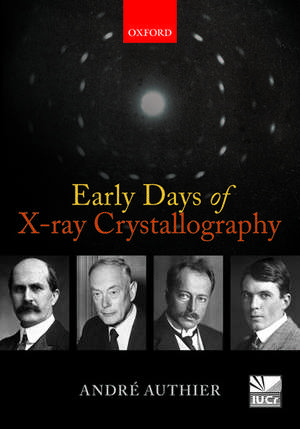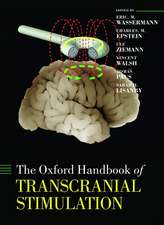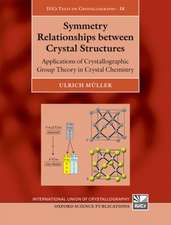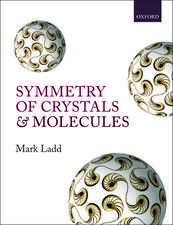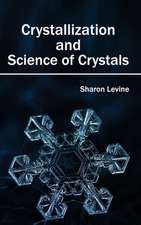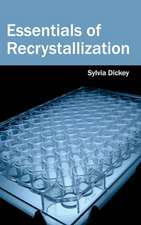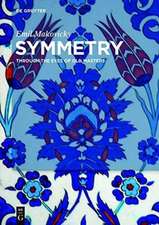Early Days of X-ray Crystallography
Autor André Authieren Limba Engleză Paperback – 29 oct 2015
| Toate formatele și edițiile | Preț | Express |
|---|---|---|
| Paperback (1) | 269.42 lei 10-16 zile | |
| OUP OXFORD – 29 oct 2015 | 269.42 lei 10-16 zile | |
| Hardback (1) | 501.13 lei 31-37 zile | |
| Oxford University Press – aug 2013 | 501.13 lei 31-37 zile |
Preț: 269.42 lei
Nou
Puncte Express: 404
Preț estimativ în valută:
51.57€ • 56.04$ • 43.35£
51.57€ • 56.04$ • 43.35£
Carte disponibilă
Livrare economică 21-27 martie
Preluare comenzi: 021 569.72.76
Specificații
ISBN-13: 9780198754053
ISBN-10: 0198754051
Pagini: 464
Ilustrații: 203 b/w illustrations
Dimensiuni: 175 x 240 x 21 mm
Greutate: 0.86 kg
Editura: OUP OXFORD
Colecția OUP Oxford
Locul publicării:Oxford, United Kingdom
ISBN-10: 0198754051
Pagini: 464
Ilustrații: 203 b/w illustrations
Dimensiuni: 175 x 240 x 21 mm
Greutate: 0.86 kg
Editura: OUP OXFORD
Colecția OUP Oxford
Locul publicării:Oxford, United Kingdom
Recenzii
Readers of the Early Days of X-ray Crystallography from both camps will be rewarded by a thoroughly researched account on the multiple faces of a scientific specialty. Historians of science will find here a rich source for further study. Crystallographers will appreciate the lesson that the historical roots of their discipline are more ramified than it may appear from a mere rational reconstruction of ideas and concepts.
I consider Authier's book as, at the present time and for a long time to come, the most complete History of Crystallography and the topics connected with it. It will be an indispensable tool for further research and a treasure trove for everybody interested in the history of scientific ideas
André has created an historical tour de force: every page contains precious nuggets of much interest...This fluently written, scholarly treatise, covers not only the early days of X-ray crystallography but also it sets the historical context in the centuries leading up to the discovery of X-ray diffraction, and what followed therefrom. Historians of science will enjoy reading it, as will students and researchers in crystallography, chemistry, biochemistry, solid-state physics, materials science, and mineralogy.
While maintaining its main goal of describing the historical and scientific context in which X-ray crystallography originated, the book is a well conceived excursion through the history of science in the 20th century. [] Brilliant and appropriate quotations, as subtitles of the chapters, and many figures, pictures, and short biographies of the main characters embellish the text. Interrelations among scientists, their collaborations and controversies over the proper interpretation of X-ray diffraction by crystals are presented in a fetching way: most famous and less famous scientists come in and out of the story at the appropriate moment and their contribution is clearly explained.
To sum up, one of the leading players in the modern era of X-ray crystallography, Andre Authier, has produced with this book a work of true devotion and incomparable detail. I Found the book to be a captivating read. It should be studied by all with an interest in where we came from in our field of crystallographic science, and is a guide to where we are going.
Professor Authier has exquisitely brought those Early Days to life, with a very human and entertaining account of the science, rigorously described, spiced with many little known personal and biographical details resulting in a story revealing how it really happened. The newcomers to the field will be exposed to a proud scientific enterprise and tradition that will be appreciated and treasured by the growing community of practitioners of the discipline that has produced a record number of Nobel prizes.
This is the definitive account of the discovery that truly changed our world. This thorough study, with its wealth of historical detail, should be required reading for everyone seriously interested in crystals.
The title of the volume underestimates the richness of its content, which is much larger. This clear, rigorous and well balanced review of the early developments of crystallography and X-ray diffraction will be indispensable for all students and scientists interested in the field.
A comprehensive and enthralling opus of encyclopedic and historical character!
This fluently written, scholarly treatise, covers not only the early days of X-ray crystallography but also it sets the historical context in the centuries leading up to the discovery of X-ray diffraction, and what followed therefrom. Historians of science will enjoy reading it, as will students and researchers in crystallography, chemistry, biochemistry, solid-state physics, materials science, and mineralogy.
This marvellously eclectic book provides and almost encyclopaedic source of how we know what we know about the structures and properties of crystals, and Andre Authier tells it with an intellectually and scientifically rigorous and constantly entertaining way. [] Since I received the book, it has provided many hours of delightful reading, browsing, and reminiscing, and has already served me well as a sourcebook for writing and lecturing. It documents a rich history and tradition of which all crystallographers should be proud, and it should enjoy a cherished place on the bookshelf of anyone with an interest in science, history, and the human role in creating the two.
It is very clear that Authier has labored long and hard and as a result has done a good job presenting a history of crystallography
...a highly valuable source for a future history of these important developments in twentieth-century science.
[...]Early Days of X-ray Crystallography is a remarkable scholarly book, good to know and consult for historical facts [...]
I consider Authier's book as, at the present time and for a long time to come, the most complete History of Crystallography and the topics connected with it. It will be an indispensable tool for further research and a treasure trove for everybody interested in the history of scientific ideas
André has created an historical tour de force: every page contains precious nuggets of much interest...This fluently written, scholarly treatise, covers not only the early days of X-ray crystallography but also it sets the historical context in the centuries leading up to the discovery of X-ray diffraction, and what followed therefrom. Historians of science will enjoy reading it, as will students and researchers in crystallography, chemistry, biochemistry, solid-state physics, materials science, and mineralogy.
While maintaining its main goal of describing the historical and scientific context in which X-ray crystallography originated, the book is a well conceived excursion through the history of science in the 20th century. [] Brilliant and appropriate quotations, as subtitles of the chapters, and many figures, pictures, and short biographies of the main characters embellish the text. Interrelations among scientists, their collaborations and controversies over the proper interpretation of X-ray diffraction by crystals are presented in a fetching way: most famous and less famous scientists come in and out of the story at the appropriate moment and their contribution is clearly explained.
To sum up, one of the leading players in the modern era of X-ray crystallography, Andre Authier, has produced with this book a work of true devotion and incomparable detail. I Found the book to be a captivating read. It should be studied by all with an interest in where we came from in our field of crystallographic science, and is a guide to where we are going.
Professor Authier has exquisitely brought those Early Days to life, with a very human and entertaining account of the science, rigorously described, spiced with many little known personal and biographical details resulting in a story revealing how it really happened. The newcomers to the field will be exposed to a proud scientific enterprise and tradition that will be appreciated and treasured by the growing community of practitioners of the discipline that has produced a record number of Nobel prizes.
This is the definitive account of the discovery that truly changed our world. This thorough study, with its wealth of historical detail, should be required reading for everyone seriously interested in crystals.
The title of the volume underestimates the richness of its content, which is much larger. This clear, rigorous and well balanced review of the early developments of crystallography and X-ray diffraction will be indispensable for all students and scientists interested in the field.
A comprehensive and enthralling opus of encyclopedic and historical character!
This fluently written, scholarly treatise, covers not only the early days of X-ray crystallography but also it sets the historical context in the centuries leading up to the discovery of X-ray diffraction, and what followed therefrom. Historians of science will enjoy reading it, as will students and researchers in crystallography, chemistry, biochemistry, solid-state physics, materials science, and mineralogy.
This marvellously eclectic book provides and almost encyclopaedic source of how we know what we know about the structures and properties of crystals, and Andre Authier tells it with an intellectually and scientifically rigorous and constantly entertaining way. [] Since I received the book, it has provided many hours of delightful reading, browsing, and reminiscing, and has already served me well as a sourcebook for writing and lecturing. It documents a rich history and tradition of which all crystallographers should be proud, and it should enjoy a cherished place on the bookshelf of anyone with an interest in science, history, and the human role in creating the two.
It is very clear that Authier has labored long and hard and as a result has done a good job presenting a history of crystallography
...a highly valuable source for a future history of these important developments in twentieth-century science.
[...]Early Days of X-ray Crystallography is a remarkable scholarly book, good to know and consult for historical facts [...]
Notă biografică
André Authier is Professor Emeritus at the Institut de Minéralogie, de Physique des Matériaux et de Cosmochimie, Université P. et M. Curie in Paris. He was Full Professor at Paris University and former president of the International Union of Crystallography.
